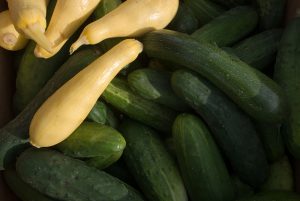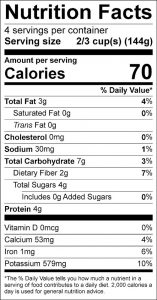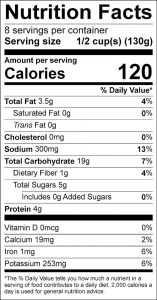Bulletin #4257, Vegetables and Fruits for Health: Zucchini and Summer Squash
 Revised and updated by Extension Educator Kate Yerxa, University of Maine Cooperative Extension.
Revised and updated by Extension Educator Kate Yerxa, University of Maine Cooperative Extension.
Originally developed by Extension Nutrition Specialist Nellie Hedstrom, University of Maine Cooperative Extension.
For information about UMaine Extension programs and resources, visit extension.umaine.edu.
Find more of our publications and books at extension.umaine.edu/publications/.
There are two main types of squash: summer and winter. Winter squash varieties—such as acorn, butternut, and buttercup—are picked at the mature stage. They have hard shells with firm flesh and seeds.
Zucchini and other summer squash varieties, which are harvested at the immature stage, have soft shells and tender, light-colored flesh. Other varieties of summer squash include patty pan, yellow crookneck, and yellow straightneck.
Nutrition Information
Like cucumbers, summer squash are 95 percent water. The high water content makes summer squash a low-calorie food. A cup of raw zucchini contains only 20 calories. Summer squash are generally a good source of vitamin C, with the amount of vitamin C varying by variety. They are also a good source of potassium.
Selection
Harvest summer squash fruits from your garden when they are still small or medium in size. You may find that if you leave them just one more day, they will be too large to have the mild, firm texture and flavor that is best. Large summer squash fruits have very large seeds, tough rinds and stringy, coarse flesh.
In Maine, look for summer squash from local farmers from July through September. When buying from your local farmer or supermarket, choose squash that are firm and heavy for their size. Skins should be sound, glossy, and without nicks, bruises, or decay. Look for bright green or yellow squash, and avoid squash that are shriveled and dried out.
Storage
Store unwashed summer squash in the refrigerator crisper in an open or perforated plastic bag. From the market, the squash will keep for up to a week. From your garden, you can expect them to keep slightly longer.
Preparation
Wash and trim summer squash before cooking. Peel and seed any older, tougher, oversized squash. Cut squash to appropriate size when preparing your recipe.
Raw: For a low-calorie snack, wash and cut small squash into strips, rounds, or chunks and eat them with low-fat dips or hummus—or add them raw to salads.
Baking: Cleaned squash can be sliced or left whole and baked with seasonings, herbs, and other vegetables. Try it with onions, tomatoes, and breadcrumbs for a tasty dish. Cook in a 350ºF oven for 30 to 35 minutes. Young, tender squash cut in slices or halves take less time to cook. Larger, tougher squash should be seeded before baking.
Steaming: Cleaned squash can be cut into bite-sized pieces or rounds and placed in a steaming basket over 1 inch of water. Cover squash, bring water to a boil, and steam for 4 to 5 minutes. Small squash (1 to 2 inches long) can be steamed whole, but will take 10 to 12 minutes.
Sautéing or stir-frying: Both methods are great ways to prepare squash. Slices or chunks can be sautéed in a little oil, in water, or in stock. Add squash to a stir-fry with other light-flavored vegetables. Stir and toss the vegetables while cooking. The cooking time for both methods is only 3 to 6 minutes.
Microwaved Zucchini or Yellow Squash
1/2 cup onion, chopped
1 tablespoon water
4 cups zucchini or yellow squash, sliced
2 tablespoons almonds, sliced
1 teaspoon margarine
1/2 teaspoon marjoram
1/2 teaspoon lemon juice
1/8 teaspoon cayenne pepper
1 tablespoon grated Parmesan cheese
In a 3-quart microwavable casserole dish, combine onion and water. Cover and microwave on high power for 2 minutes. Stir in zucchini or yellow squash. Cover and cook on high for 5 minutes. Drain. Brown almonds in a small skillet in melted margarine. Sprinkle over drained vegetables. Sprinkle with marjoram, lemon juice, and pepper. Toss, then cover and microwave on high for 1 minute. Before serving, sprinkle with Parmesan cheese.
Zucchini Bake
3 cups zucchini, sliced
2 cups tomatoes, cut in chunks
1 cup onions, sliced
1 teaspoon salt
1 1/2 teaspoon Italian seasoning
dash cayenne pepper
Arrange zucchini, tomato, and onion in a lightly greased casserole dish. Sprinkle seasoning over the mixture. Bake at 350ºF for 30 to 45 minutes, depending on how well-cooked you want the vegetables.
Squash Stuffing
1 tablespoon margarine, melted
1 small package herbed stuffing
2 cups zucchini, cut into bite-sized pieces
1 cup onion, chopped
3 carrots, shredded
1 cup low-sodium chicken brothPut the herbed stuffing, reserving 1 cup, in a 3-quart casserole dish. Combine all other ingredients with the stuffing mix. Pat lightly into the casserole dish. Sprinkle the reserved stuffing cubes on top. Bake at 350ºF for 45 minutes.
Some content adapted with permission from University of Massachusetts Cooperative Extension.
Information in this publication is provided purely for educational purposes. No responsibility is assumed for any problems associated with the use of products or services mentioned. No endorsement of products or companies is intended, nor is criticism of unnamed products or companies implied.
© 2008
Call 800.287.0274 (in Maine), or 207.581.3188, for information on publications and program offerings from University of Maine Cooperative Extension, or visit extension.umaine.edu.
The University of Maine is an EEO/AA employer, and does not discriminate on the grounds of race, color, religion, sex, sexual orientation, transgender status, gender expression, national origin, citizenship status, age, disability, genetic information or veteran’s status in employment, education, and all other programs and activities. The following person has been designated to handle inquiries regarding non-discrimination policies: Sarah E. Harebo, Director of Equal Opportunity, 101 North Stevens Hall, University of Maine, Orono, ME 04469-5754, 207.581.1226, TTY 711 (Maine Relay System).




